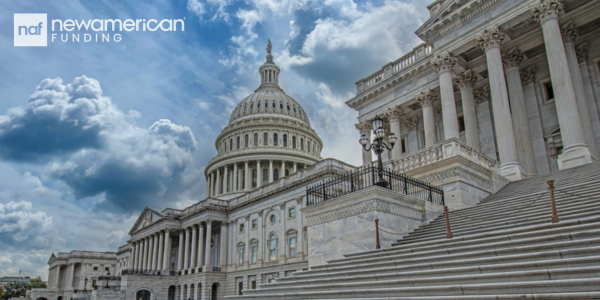Housing News, Videos
Putting the Market in Perspective
December 10, 2020
Alexis: Hey, everybody! Welcome back to the Mortgage Rundown. My name is Alexis Quinney and I'm here with Jason Obradovich, CIO of New American Funding. How have you been doing, Jason?
Jason: I've been doing really well. Thank you. How are you?
Alexis: Good, good. It's been a minute since we talked, so I have a few questions for you. Since our last update, what is the state of the market right now?
Jason: You know, really, there hasn't been a lot of change, both with Treasury rates and mortgage rates. You know, I think we talked about that before. Treasury rates are moving up very subtly, but mortgage rates are actually moving down. And so, over the month of November and a little bit into December, mortgage rates are ticking down ever, ever so slightly. So, not a ton of changes. We've had the election. We think it's over. We think the results are going to get certified. We think there's going to be a new administration. There are still some unknowns around the Senate. And so, some of those things are starting to crystallize. There really hasn't been a lot of change in the market itself.
Alexis: OK, got it. So, things are still staying pretty even there?
Jason: Right.
Alexis: So, speaking of the election, something else that's come up since we last spoke is talk of a vaccine. So, I kind of wanted to get your take on how this vaccine relates to the election and how it's going to affect the market moving forward.
Jason: Right. Yes. So, we have the election. There could be a lot of changes, both in terms of administration, but all the different appointments, you know, whether it's in housing and other markets. Obviously, the new administration is going to want to do as much as they can in their first year. Right? Because that's where they have the most momentum to do something. And what they're going to do is we don't necessarily know yet. We do know that there is a COVID plan. Right? There's probably likely going to be either a mandate or a request for everyone to wear masks for at least 30 days, if not longer. Right? They're going to want to tackle the virus as soon as they can. And we also have seen many different companies that say they have a vaccine. How that's going to be distributed, who is going to be offered to, how many doses, what the impact that will be on reopening, how much that will impact the economy—everyone's just guessing. We really don't know how that's still going to play itself out. So really, I don't think there's been a lot of information and how much that's going to affect the market or the economy, you know, for probably for a couple of months. I hate to say it, but I just think that's the most likely cause.
Alexis: OK, got it. So, another question I had was compared to other recessions we've had in the past, how does what we're going through right now kind of relate? How can we put that into perspective?
Jason: Yeah, you know, this is a very unique market, right? I've even told my kids, like, what we're going through now like I never had to go through as a kid. And so, you have to take everything into the context of this is so different than anything that anyone alive today is probably really ever dealt with in their lives. And so, one of the things I wanted to do, just to give the viewers some perspective, is I want to show two graphs. And so, on your screen, you'll see one chart. The first chart is just GDP, United States GDP for the last 50 years or 49 years prior to COVID. So, from 1970 through 2019, this is quarterly GDP and you can see the lines go up and down. Right? One-quarter things grow. The next quarter things shrink, and you can see anything below the line ‘zero’ generally is a recession. And so, you'll see times in the mid-70s, in the early 80s, I think early 90s, early 2000s, and then, of course, 2007-2008 with the Great Recession. And so, you see these swings up and down. And especially if you look at 2007-2008, you can see it really swung down. Right? This was the Great Recession. This is when we saw economic activity really retract. We saw a lot of lives destroyed economically. And so, it was a really tough time.
And then the next chart, if you were to move forward, is taking that same data and now overlaying it with COVID—everything we've dealt with COVID. And so now all of a sudden, those big swings that you saw really, really start to shrink. Because what we're dealing with COVID is the amount of retraction we saw within the economy was over 30 percent. You know, the Great Recession, the biggest swing it was I think it was around eight percent. So COVID was 30 percent. Now, COVID may not last as long as the Great Recession. And we've done some smart things in terms of dropping rates, creating forbearance programs. There's been a lot of stimulus that's come in right away. So, I think we've dealt with it a lot better. But in terms of the amount of change, it's unprecedented. I mean, greater than the Great Depression. You know, the Great Depression was longer. But this in terms of the percent change in economic activity is unprecedented. So, I just want to give my hats off to everyone who's had to deal with this, our politicians, economists, the Federal Reserve. Everyone's just done a great job because when you look at it in the context of everything in the history of this country for the last 50 years, it's unprecedented.
Alexis: Yeah, definitely. And I think, I mean, it makes me feel a little bit saner and we have gone through so much this year and how we've handled it a lot differently. And, yeah, it's just it's very cool to see that perspective of how it's gone now versus then. So, thanks for that insight.
Jason: Yeah, I think it's important for people to remember the context. Right? Like you're in the middle of something you think it's going to last forever and it's like, it's not. But look, in the context of what you've had to deal with. And so we, as much as we want to know what's going to happen next quarter or are interest rates going to go up and we have some of these dialogues, one of the things you need to remember is that for the last 40 years of our life, interest rates have really just done nothing but go down. Yeah, there have been years where they've gone up a year or two, but for the most part, interest rates just go down and down. And that's just the sign of things probably to come. So, yeah, you know 2021 rates are probably going to stay low. 2022, we don't know. Rates might go up a little bit, we don't really know. But by and large, rates keep going down. People don't need to worry that suddenly tomorrow's rates are going to go to eight percent. I know they're in the kind of the twos right now, but just take things in the context that we're not going to see any huge swings in rates and we have dealt with a lot.
Alexis: Yeah, definitely. Well, those are all my questions for today. I think this was a great update. And I just want to thank you for taking the time with me today.
Jason: Absolutely. I hope you have a great rest of your week. If I don't see everyone before the holidays, happy holidays and we'll see you next year.
Alexis: All right. Bye Jason!
Jason: Bye everyone!




 Smart Moves Start Here.
Smart Moves Start Here.